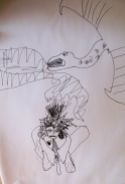Young children have more time in which they are untroubled than adults. They have therefore more inspirations than adults. The moments of inspiration added together make what we refer to as sensibility — defined in the dictionary as “response to higher feelings.” The development of sensibility is the most important thing for children and adults alike, but is much more possible for children. – Agnes Martin
Recently, I was having a conversation with my ten year old son about drawing.
ME: Why do you draw?
HIM: Because I enjoy it.
ME: How do you decide what to draw?
HIM: Just depends what I feel like drawing.
ME: You draw a lot of characters from books and films. Why is that?
HIM: I see or read something and I want to create my version of it.
ME: I wonder why a lot of people stop drawing when they get older.
HIM: Why can’t adults just do it? All you need to do is pick up a piece of paper and draw something you like. It’s very simple.
Children are naturally alert to the whispers of inspiration; they live mostly in the moment where it’s easy to connect with joy and curiosity, so creativity naturally flows through them.
But inspiration, artist Agnes Martin argues in her handwritten notes for a student lecture, (included in Agnes Martin: Paintings, Writings, Remembrances), cannot be controlled or willed — it can only be surrendered to. She illustrates this by way of the child:
What is the experience of the small child in the dirt? He suddenly feels happy, rolls in the dirt probably, feels free, laughs and runs and falls. His face is shining… “The light was extraordinary, the feeling was extraordinary” is the way in which many adults describe moments of inspiration. Although they have had them all their lives they never really recall them and are always taken by surprise. Adults are very busy, taught to run all the time. You cannot run and be very aware of your inspirations.
Julia Cameron, author of the insightful Artist’s Way: A Course in Discovering and Recovering your Creative Self, agrees:
I believe that every person is creative and that, as adults, we tend to stray from some of the natural inclinations we were born with. Creativity is the natural order of life. Life is energy:pure creative energy.
What I like about the Artist’s Way is how Cameron links our inherent creativity to spiritual experience. One of the tenets of the book is that our creative dreams and yearnings come from a divine source and as we move toward our dreams, we move towards our divinity. You don’t have to believe, you simply have to observe and note the process as it unfolds. The faith is in moving out into the flow of creation.
Cameron advises us to listen to our creative child as it tells us when our art needs more playful inflow. After all, imagination-at-play is at the heart of all good work.
The creation of something new is not accomplished by the intellect but by the play instinct acting from inner necessity. The creative mind plays with the objects it loves. – C.G. Jung











